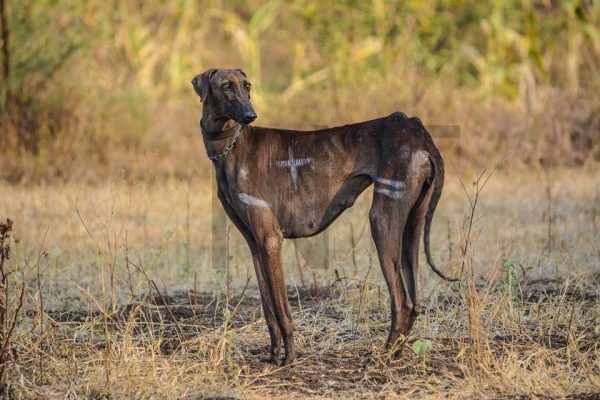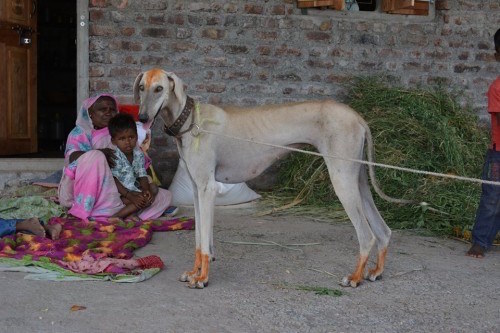
Because of the time difference between the USA and India, the Caravan Hound has one of the most challenging Purebreds of Interest that National Purebred Dog Day has covered thus far, but it has also been one of the most gratifying because so few people are aware of the breed.
Caravan Hounds came to India with traders and mercenaries traveling in caravans from Central Asia and Arabia. The breed is related to Afghan Hounds, Salukis, Tazis/Tazys, Xigous – they’re all part of the continuum of Asiatic sighthounds that stretches from China to Turkey, and thus share many features in common with the others. Their histories are interwoven (think Silk Road) and they share a common function – coursing game, mostly hare and ungulates, over vast expanses of arid land. The Caravan Hound was built to endurance run, and it makes sense that its standard is precise on this point: “Must have thick heel pads, long third digit with upright second digit, must be compact and firm and of muscular tension. These conditions are even more important for the hind feet.”
Sadly, the breed in its purest form is now found largely in remote, rural areas. Crossbreeding with Western sighthounds has occurred in both racing lines and show lines. The differences in conformation are quite great. Caravans should conform to the basic Asiatic type: A rather “square” dog, unmistakably Asiatic in type. Moderate and balanced angulation fore and aft. Overdone rears are not “typey” in an endurance running hound. Musculature is lean and dry. The hip bones are usually noticeable and the top line is either level or slopes slightly from the rear to the front. There is a very slight arch over the loin. Very slight. The chest is deep, reaching usually to just above the elbow, sometimes to it, and the underline rises into a noticeable tuck up. Long, tubular bodies are not “typey.” The head and neck are approximately the same length, and many people like a rather refined but not spiny head – this has nothing to do with function but more to do with aesthetics. The tail reaches approximately to the hock and is very thin.
Crosses, on the other hand, have small ear leather, tubular bodies, over-angled rears, sloping toplines or exaggerated arch, and often displays colors/patterns not common in rural dogs. We had to look at many, many pictures of purebred Caravan Hounds, and compare them with pictures of Caravan crosses to learn to tell the difference. Once we “got it,” there was no going back. An undiluted Caravan Hound is a spectacular beauty, and Greyhound crosses are, in our estimation, not to be remotely the same.
Why was the breed cross-bred at all?
As far as we could tell, a subtle transformation was occurring in the breed as it has moved from a rural hound to show dog. Greyhound blood worked its way into the breed, in some measure because of the British influence in India. A population of Greyhound x Caravan Hounds was present in the Deccan, dogs called “Alaknoori,” and they were considered distinct from pure Caravans. That said, some urban breeders unwittingly crossed these lines into their purebred Caravans thus adding another source of Greyhound blood.
Too, Greyhounds were used to cross into some show lines of Caravans, possibly because some breeders felt that Greyhounds added muscle, length, and angles, and also softened temperaments which made the breed easier to handle in the show ring. More recently, these “mixed” Caravan lines were bred into some rural populations for racing purposes since hunting is becoming very difficult and is technically illegal. Greyhounds, while ideal for racing, aren’t up to hunting in the tough Deccan ground.
As far as we’re able to glean, the show community in India is removed from rural people who keep authentic Caravans, and consequently, many show judges have been exposed only to dogs that, while flashy and extreme, aren’t authentic Caravan Hounds.
Foreign judges (and many Indian judges) don’t speak the local language (Marathi) and thus aren’t able to access rural areas, let alone interact with the owners of the real Caravan Hounds. Thus the “nouveau type” has become the Caravan Hound that the KCI and the international dog world is coming to accept as correct and authentic. This is of great concern to the breed purists.
When we featured the breed as a POI back in 2014, a common question was with regards to the Caravan’s relationship with other Indian breeds. We learned from owners that Rampur Hounds are from Northern India, an area known as Rampur in what is now the state of Uttar Pradesh. They were big game coursing hounds kept by the Nawabs of Rampur, and specialized in hunting the Nilgai (blue bull). Records suggest that this was a large, powerful hound, and most people agree that this old type of Rampur no longer exists. Today, all the Rampurs that exist are basically Greyhounds.
At one time and in some circles, Rampurs and Mudhol Hounds “were” the same as Caravans, even as recently as 10 years ago. However, the state government of Karnataka set out to create a “state breed” which is today markedly different from the aboriginal Karwani of Maharashtra. The Mudhol today is a much taller dog, usually white in color, sometimes parti-colored (white and brindle or white and black) and some say that the modern lines have a heavy infusion of Alaknoori and/or Rajapalayam.
As of 2014, FCI recognition was within sight for this breed, and interest in the Caravan was growing in Europe and elsewhere. Little is known about the breed outside of its native India, but there has been serious concern among breed purists that the authentic Caravan is being lost, while the mixed version is being promoted as the “real deal.” National Purebred Dog Day will continue to spread the word that in Caravan Hounds, one must do their homework. This is a breed at risk due entirely to cross-breeding.
Our thanks to Neil Trilokekar who was an enormous help in our journey to learning about the Caravan Hound. We are indebted to him for his patience and generosity in sharing his photos.
Image of a Caravan Hound by Neil Trilokekar


Sadly with most genuine breeds of dog’s, end up get ruined by the show scene. I had hairless dog’s years ago. The only true hair less dog’s would not have had a chance towards the dog’s that ended up winning in the show ring, because the flashy dog’s that were winning where basically shaved powder puffs and not true hair less.